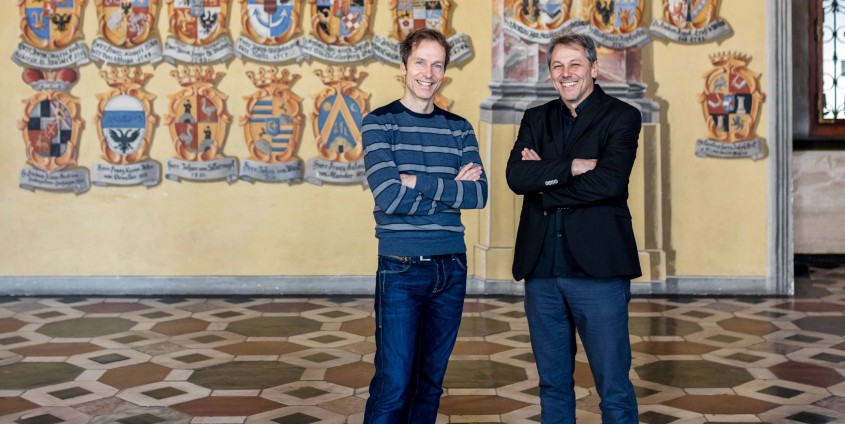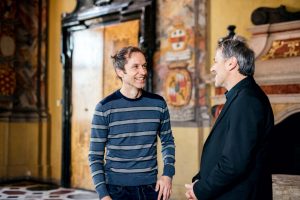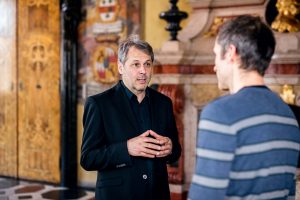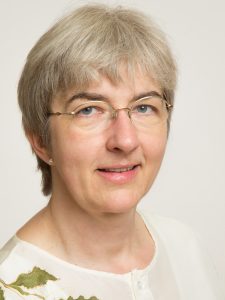German-Mandarin, Syrian-German or Slovenian-German? On the valences of multilingualism
The nation state idea aspires to perfect monolingualism. The field of linguistics, on the other hand, regards multilingualism as something normal. And not all forms of multilingualism are alike: While some educated middle-class parents may opt to send their children to Mandarin lessons while they are still in kindergarten, Syrian-German speakers receive very little societal respect. ad astra spoke to the linguist Alexander Onysko and the educational scientist Hans Karl Peterlini about the status of multilingualism.
How multilingual is your daily life?
Onysko: Simply due to the nature of my work, my daily life is quite multilingual. At the Department of English and American Studies, English is our colloquial language. Here, German is my secondary language. Besides, my wife is Italian and an English linguist. Our first child was recently born, and we would like to raise it trilingually – i.e. with English, German and Italian.
Peterlini: My everyday life is less multilingual than one might expect of somebody who, like me, comes from a bilingual area such as South Tyrol. English is barely present in my daily routine; it tends to be limited to reading matter. At home, German is our family language. I was accompanied throughout my childhood by the Italian spoken by my grandparents. And yet, in my family we did not succeed in adding Italian to the mix, as it would have seemed artificial. I was hoping to prepare my youngest son for the Italian kindergarten by starting to speak to him in Italian in the preceding summer. He got quite worked up and demanded: “Daddy, speak normally!”. At kindergarten, he found his bearings very quickly and picked up the new language. The rule with kids is simple: If you don’t make a fuss, they won’t make a fuss. My big resolution here in Carinthia is to learn at least the basics of Slovenian or Bosnian/Croatian/Serbian. I haven’t managed it yet, but I do enjoy listening to the melody of the language, whenever my colleagues speak Slovenian amongst themselves.
You have a positive perspective on multilingualism. How might one explain why some people fear it so deeply?
Peterlini: There is this sinister linkage in the nation state between demos and ethnos. It is believed that the nation state requires a people that speaks one language. Linguistic plurality is conceived as dysfunction.
Was this always the case?
Peterlini: In ages past, multilingualism was carefully cultivated at court: The privileged classes were absolutely allowed to chatter in French and Latin. The common people, on the other hand, had to be monolingual, because it was believed that bilingualism overtaxes the mind and the character. In some quarters, traces of this linguistic ideology still linger today. A second or third language is believed to harm the primary language to some degree.
Onysko: That is an unsatisfactory approach to multilingualism. The assumption does genuinely exist that, in studies, children growing up in a multilingual context will prove to have a smaller vocabulary when compared to monolingual children. In joint school situations this is often handled inadequately, resulting in an inevitable downward spiral.
What does the field of linguistics say on this matter?
Onysko: The findings are quite clear: Overall, multilingual children have the same vocabulary capacity and are able to compensate for any deficiencies over the course of the years spent living and learning. By the time they reach the age of 11 to 12, most children are equally proficient in both languages. Success depends on the language input. Basically, what is important is to be patient and to make the effort to explain and to educate, so that these children are encouraged appropriately in the schools. Teachers should have the opportunity to recognise that these children develop absolutely normally.
What are the effects of multilingualism?
Onysko: Studies show that children who grow up multilingually are better able to switch from one task to another, for example when sorting images first by colour and then by shape. They are quicker at this task. They appear to possess a greater cognitive flexibility; in other words, something that also manifests itself in living with others.
Do you understand that schools nonetheless prefer to be managed monolingually?
Onysko: Schools often follow a language ideology that provides for the “perfect” command of a language. This requires standards that must be met. If only one language is being spoken, it simplifies organisational processes. As things stand today, our society is not structured in such a way that several languages can simply happen alongside each other.
Peterlini: The schools are under tremendous pressure to produce perfect monolingualism, or to elicit it from the children. However, this perfect monolingualism is a myth, which basically does not exist. The cognitive flexibility of the multilingual, which was mentioned earlier, represents a gain on many levels. Nowadays, skills such as being able to switch between different systems and codes, successfully navigating through various problems, translating between challenges, which may have nothing to do with language, are absolutely essential. This is also significant for the monolingual individual: They, too, have something akin to a form of inner multilingualism, for example when they shift from dialect to the standard language, or when they adapt their speech to the respective situation.
Are we moving forwards or backwards at the moment?
Peterlini: There is a fantasy that multilingualism is a threat to the national culture. Even though these may simply be husks and empty phrases: Today, more people than ever seem to feel threatened in their national culture. That is why I tend to feel that things are moving backwards, at least in the regional structures I am familiar with.
What is the situation like in South Tyrol?
Peterlini: Official bilingualism is exemplary there, everything is signposted and labelled in two languages. In the small number of places where Italian-speaking and German-speaking South Tyrolese live side by side, people switch smoothly between the languages and their approach here is quite matter of fact. However, in terms of the linguistic-geography situation, there are extensive monolingual areas, where Italian merely maintains a formal presence. The school system is split, with a primary and a secondary language. In recent years, there have been some tolerated attempts at infiltration, for instance subject teaching in the secondary language, increasing the number of lessons in the secondary language, but also enrolments in the respective other school; i.e. Italian children attended the German school and vice versa. Now, there are demands for stricture rules to be reinstated in many places. A truly multilingual school is a politically emotive issue in South Tyrol.
What is currently happening in Carinthia despite many discussions permeated by fear, for instance in the Volksschule 24 primary school in Klagenfurt, namely one week of lessons in German and one week of lessons in Slovenian, would represent a never previously considered novelty for South Tyrol.
Where in the world is harmonious multilingualism practised?
Onysko: The idea of the nation state with a single language originated in Europe and also spread from here. Internationally, there are some areas, which feature a greater degree of multilingualism and which handle it more naturally. To give an example: Within the post-colonial context, English remains a strong presence in many African countries, and it serves as an inter-ethnic connecting language wherever many other languages are spoken. In India, where there are in excess of 600 languages, 67 of which are used as languages of instruction, children customarily learn English, Hindi and their regional language. Languages also fulfil different functions there and are used in social contexts. Generally, it might be fair to say this: In locations where many languages are spoken, multilingualism is also enjoys a greater degree of social representation.
To what extent can the state intervene here?
Onysko: Many things are possible, but then again, quite a few are not. I was able to conduct a number of studies in New Zealand, and became acquainted with the relationship between the Māori and the New-Zealand Europeans. Māori has a flagship status: There are Māori schools, Māori kindergartens and Māori-adapted structures wherever you go. Superficially, official bilingualism is ubiquitous, and there are several initiatives aimed at representing the minority language to an even greater extent in everyday life. However, behind this there still lurks a pronounced societal dichotomy and few incentives exist to use the Māori language outside of Māori settings. Educated Māori are bilingual and bicultural, and are able to navigate both worlds. Unfortunately, many of the Māori grow up speaking only English, and so the indigenous language of New Zealand continues to be at risk of extinction. The less educated are not successful at this and they are pushed to the social margins, perforce together with their language.
Peterlini: Language is also political, because it facilitates participation in social life. Particularly in places where majority-minority spaces occur, questions of power distribution and of political speech force their way into the discourse. In South Tyrol, the minority language German is admittedly strong, and can afford to move towards compartmentalization. The Slovenian language in Carinthia is not among the prestigious languages and is further tainted by having been the language of the ideological enemy. This inevitably results, albeit often subliminally, in a struggle for the right of the weaker party to exist.
How does the addition of new migrant languages shake up power relations?
Peterlini: It’s fascinating. In the Canadian province of Québec, for instance, migrants have to enrol in the French school as a matter of principle, to ensure that the French minority is not weakened. In South Tyrol, migrants are able to elect the school freely, and the distribution is roughly equal. However, because there are significantly fewer Italian schools, the so-called migration density tends to be far greater there. This now leads to two ethno-discourses: On the one hand, the foreign language speakers in the German schools are feared, because then it will no longer be possible to learn proper German there. On the other hand, they are also feared in the Italian schools, because this would mean that overall a greater number of Italians would grow up there, and one could conceivably end up in the role of the minority. In all this, the highly political debate about language as a symbol masks social issues, which actually bear far greater relevance.
Imagine a teacher who is facing her class; only a few of the children speak German and the diversity has become an unmanageable daily problem coupled with social challenges: What would your advice be?
Onysko: That is difficult to solve, not least because our society assigns every language a certain valance, and the migration languages are not well respected. While the current weighting remains intact, there will always be an effort to push back the languages of origin in favour of the German language. Fostering both their languages and the people appropriately will lead to less tragedy for everyone in the long run. There is also an underlying political question: Are we truly willing to give something to those who come to us, even if it is merely a space for their language? As a linguist, my view is this: Multilingualism is normal and it benefits the cognitive development. Everyone can profit from it.
Peterlini: The question that asks what form school should take is not based on the actual circumstances but rather on an educational objective. If the aim is to ensure that, within a short time, migrant children must be as good at German as educated middle-class German-speaking children, then school is doomed to failure. At present, linguistic and cultural wealth is being discarded and people are crumpled before they can even stand up. We need to look very carefully: What is the situation? What does this type of school need? Who can be usefully involved? If the schools were allowed to act more freely, they would be able to make great progress. We do know this: The greater the regard for the language of origin, the greater the learning achievement in the target language. Proof that highly diverse schools can succeed is already being provided wherever teaching staff are allowed to work creatively and where they are liberated from rigid objectives.
for ad astra: Romy Müller
About the person
Alexander Onysko (pictured left), born in Lienz in 1974, took up the position as Full Professor in English Linguistics at the Department of English and American Studies in 2016. Since January 2018, he is also the Dean of the Faculty of Humanities. Onysko read English and American Studies at Innsbruck University. As well as spending time in the USA as a Fulbright scholar, he has held visiting professorships at the Universities of Hamburg, Bochum, Innsbruck and Gothenburg. From 2012 to 2015 he was a researcher and principal investigator at EURAC (European Academy) in Bolzano. Amongst other things, Alexander Onysko spent a period abroad conducting research at the University of Waikato in Hamilton, New Zealand, where he studied English in its interaction with the indigenous Māori language. Prior to taking up his position at the AAU, he was Associate Professor for English Linguistics at the University of Venice.
About the person
Hans Karl Peterlini (pictured right), born in Bolzano in 1961, joined the Department of Educational Studies and Educational Research in September 2014, as Full Professor in General Education Sciences and Intercultural Education. Hans Karl Peterlini completed his studies in Psychoanalytical Pedagogy and his Propaedeutic Training in Psychotherapy at Innsbruck University in 2006. Previously, he was editor-in-chief and publisher of socio-politically oriented media in South Tyrol and author of numerous studies on majority-minority issues, violent dynamics and processes of living together in historically burdened and ethnicized societies using the example of South Tyrol. He received his doctorate at the Free University of Bolzano in 2010. Four years later Peterlini concluded his habilitation at Innsbruck University’s “School of Education”. Between 2011 and 2014, Hans Karl Peterlini worked at the research centre “Education – Generation – Lifecourse” in Innsbruck, and participated as research associate in school and migration projects conducted at the Free University of Bolzano.
Background: Multilingualism in research and teaching
Since 1999, the Alpen-Adria-Universität working group “Multilingualism” has brought together researchers at the AAU, who each address the subject of multilingualism within their own discipline. The working group, headed by spokeswoman Ursula Doleschal, professor at the Department of Slavonic Studies, organises an annual lecture series, has established an elective module titled “Multilingualism”, and supports the permanent integration of the subject area within the teaching and research portfolio of the university. The working group is comprised of 17 members. Within the context of the implementation of the new teacher training degree, the Development Plan of the Alpen-Adria-Universität, which applies as of 2019, also provides for the creation of a professorship in “Multilingualism with special consideration of (foreign) language didactics”. There are other attempts elsewhere to address the current challenges arising in the increasingly multilingual daily life at schools from a sound scientific base: For instance, in recent years, efforts invested at the higher education level in Austria have also aimed at strengthening the focus on the integration of multilingualism at schools, and incorporating it in the education of teachers. The University College of Teacher Education in Vienna plays a pioneering role here.
But how (well) does multilingualism really work at schools? Vladimir Wakounig (Department of Educational Studies and Educational Research) provides scientific guidance to the Klagenfurt primary school “Volksschule 24/Ljudska šola 24”, which offers bilingual lessons on equal terms. The languages of instruction at the school, Slovenian and German, are switched in weekly rotation. Each language is tied to one particular teacher. Meanwhile, a team of researchers led by Ursula Doleschal is working on a project for the “Hermagoras Volksschule/ Mohorjeva ljudska šola” primary school in Klagenfurt. The aim of this project is to digitalise, analyse and evaluate essays and written tests produced by pupils at this bilingual school. “We want to examine the learning progress in German and in Slovenian in a bilingual primary school”, Doleschal explains. The starting points of each of these children can vary significantly, which is another reason why there is so much interest in determining the learning progress: “Some children grew up bilingually with two mother tongues, others learned Slovenian in kindergarten, while yet others arrive at this school without any native speaker knowledge of one of the two languages.” According to Doleschal, the children’s parents also express quite distinct expectations: “Some want the children to learn Slovenian, others want them to learn German. For many, the aspiration is that, given the environment, the children should grow up to be as tolerant and open-minded as possible. The school’s task is to advance the children in both languages equally, and to meet the requirements of the syllabus.” In this fascinating field of research, the current objective in Carinthia is to gain, for the first time, “more than impressionist” insights into how learning progress is reflected in the written language.














